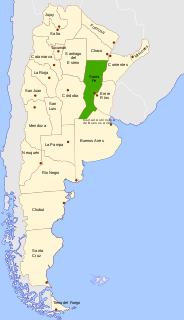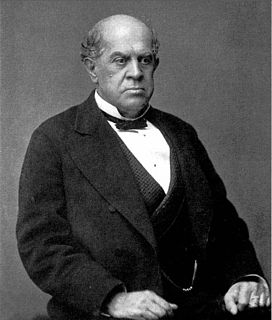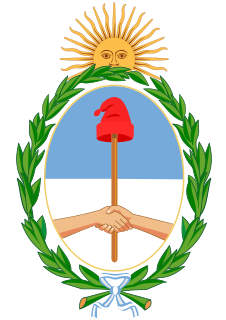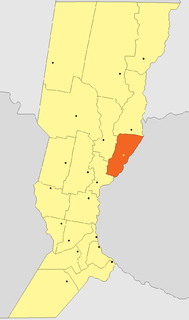This article needs additional citations for verification .(May 2014) (Learn how and when to remove this template message) |

Mariano Cabal (12 April 1830 – 1885) was the governor of the province of Santa Fe, Argentina between 9 April 1886 and 7 April 1871. [1]

Argentina is subdivided into twenty-three provinces and one autonomous city, Buenos Aires, which is the federal capital of the nation as decided by Congress. The provinces and the capital have their own constitutions, but exist under a federal system.

The Province of Santa Fe is a province of Argentina, located in the center-east of the country. Neighboring provinces are from the north clockwise Chaco, Corrientes, Entre Ríos, Buenos Aires, Córdoba, and Santiago del Estero. Together with Córdoba and Entre Ríos, the province is part of the economico-political association known as the Center Region.

Argentina, officially the Argentine Republic, is a country located mostly in the southern half of South America. Sharing the bulk of the Southern Cone with Chile to the west, the country is also bordered by Bolivia and Paraguay to the north, Brazil to the northeast, Uruguay and the South Atlantic Ocean to the east, and the Drake Passage to the south. With a mainland area of 2,780,400 km2 (1,073,500 sq mi), Argentina is the eighth-largest country in the world, the fourth largest in the Americas, and the largest Spanish-speaking nation. The sovereign state is subdivided into twenty-three provinces and one autonomous city, Buenos Aires, which is the federal capital of the nation as decided by Congress. The provinces and the capital have their own constitutions, but exist under a federal system. Argentina claims sovereignty over part of Antarctica, the Falkland Islands, and South Georgia and the South Sandwich Islands.
Major achievements of Cabal's administration were, among others, the opening of the first telegraph line between Rosario and Buenos Aires, and the railway link between Rosario and Córdoba (through the Ferrocarril Central Argentino), in 1870.

Buenos Aires is the capital and largest city of Argentina. The city is located on the western shore of the estuary of the Río de la Plata, on the South American continent's southeastern coast. "Buenos Aires" can be translated as "fair winds" or "good airs", but the former was the meaning intended by the founders in the 16th century, by the use of the original name "Real de Nuestra Señora Santa María del Buen Ayre". The Greater Buenos Aires conurbation, which also includes several Buenos Aires Province districts, constitutes the fourth-most populous metropolitan area in the Americas, with a population of around 15.6 million.

Córdoba is a city in the geographic center of Argentina, in the foothills of the Sierras Chicas on the Suquía River, about 700 km (435 mi) northwest of the Buenos Aires. It is the capital of Córdoba Province and the second most populous city in Argentina after Buenos Aires, with about 1,330,023 inhabitants according to the 2010 census. It was founded on 6 July 1573 by Jerónimo Luis de Cabrera, who named it after Córdoba, Spain. It was one of the first Spanish colonial capitals of the region that is now Argentina. The National University of Córdoba is the oldest university of the country and the seventh to be inaugurated in Spanish America. It was founded in 1613 by the Jesuit Order. Because of this, Córdoba earned the nickname La Docta.
Cabal pushed the colonized frontiers of Santa Fe Province southward, up to the current towns of Teodelina and Venado Tuerto (34° S), and northward, up to the latitude of present-day Morteros, Córdoba (about 30° 40’ S), thus bringing the area of the province to 57,000 km². The provincial government continued the policy of sponsoring settlements of European immigrants as agricultural colonies. Cabal is acknowledged as the official founder of the city of San Justo and several smaller towns, including Saladero Cabal and Emilia (named after his wife). [2]

Venado Tuerto is a city in the south-west of the province of Santa Fe, Argentina, 322 km from the provincial capital. It has about 76,000 inhabitants.

Immigration to Argentina began in several millennia BC with the arrival of cultures from Asia to the Americas through Beringia, according to the most accepted theories, and were slowly populating the continent. Upon arrival of the Spaniards, the inhabitants of Argentine territory were approximately 300,000 people belonging to many civilizations, cultures and tribes. After the Spanish conquest, an abundant number of immigrants from all over the world arrived in the country.

Agricultural colonies in Argentina were a demographically and economically important part of the evolution of the country. The Argentine government, faced with large areas of fertile land that were unpopulated or settled by aboriginal tribes, encouraged European immigration, welcoming settling agreements with countries, regions and associations abroad.
By a decree of 1869, Cabal authorized the creation of a university career including the teaching of Civil Law, Canonical Law and Natural Law at the Law School of the Jesuit-ruled College of the Immaculate Conception in Santa Fe City. This was the origin of today's Faculty of Social and Juridical Sciences of the National University of the Littoral. [3]

The Society of Jesus is a scholarly religious congregation of the Catholic Church for men founded by Ignatius of Loyola and approved by Pope Paul III. The members are called Jesuits. The society is engaged in evangelization and apostolic ministry in 112 nations. Jesuits work in education, intellectual research, and cultural pursuits. Jesuits also give retreats, minister in hospitals and parishes, sponsor direct social ministries, and promote ecumenical dialogue.

The National University of the Littoral is a university in Argentina. It is based in Santa Fe, the capital of the province of the same name, and it has colleges and other academic facilities in Esperanza, Reconquista and Gálvez, also in Santa Fe Province.
During the last year of Cabal's rule, Santa Fe contributed with the national government (led by president Domingo Faustino Sarmiento) to suffocate Ricardo López Jordán's uprising in the neighbouring Entre Ríos Province.

Domingo Faustino Sarmiento was an Argentine activist, intellectual, writer, statesman and the seventh President of Argentina. His writing spanned a wide range of genres and topics, from journalism to autobiography, to political philosophy and history. He was a member of a group of intellectuals, known as the Generation of 1837, who had a great influence on nineteenth-century Argentina. He was particularly concerned with educational issues and was also an important influence on the region's literature.

Ricardo Ramón López Jordán (1822–1889) was an Argentine soldier and politician, one of the last influential "caudillos" in the history of Argentina. He thrice rebelled against the government of Buenos Aires and was defeated in each attempt.

Entre Ríos is a central province of Argentina, located in the Mesopotamia region. It borders the provinces of Buenos Aires (south), Corrientes (north) and Santa Fe (west), and Uruguay in the east.
Once finished his governorship, Cabal was a deputy for the capital district of Santa Fe between 1871 and 1872, and a senator between 1872 and 1876. He collaborated with the reform of the provincial constitution of 1873. He was succeeded by his personal friend and minister Simón de Iriondo.

Simón de Iriondo (1836–1883) was an Argentine politician of the National Autonomist Party, who was twice governor of the province of Santa Fe, from 1871 to 1874 and from 1878 to 1882.
Cabal died in Buenos Aires at the age of 55.
| Preceded by Nicasio Oroño | Governor of Santa Fe 1886–1871 | Succeeded by Simón de Iriondo |
















